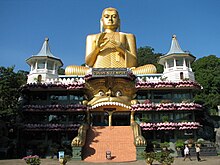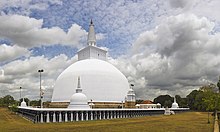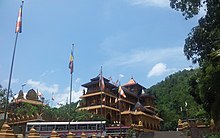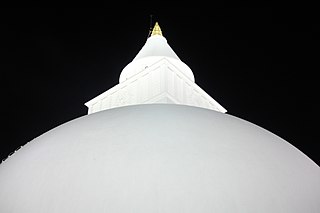
Kiri Vehera is an ancient stupa situated in Kataragama, Sri Lanka. This stupa probably dates back to the 3rd century BC and is believed to have been built by King Mahanaga brother of king Devanampiyatissa; a regional ruler of Kataragama area. One of the most popular Buddhist pilgrimage sites in the country, Kiri Vehera is among the Solosmasthana, the 16 most sacred Buddhist pilgrimage sites of ancient Sri Lanka. This stupa which is 95 ft. in height with a circumference of 280 ft. is located 800 m North to the famous Ruhunu Maha Kataragama Devalaya. Venerable Kobawaka Dhamminda Thera is the present Chief Prelate of Kirivehera Rajamaha Viharaya.

The Tissamaharama Raja Maha Vihara is an ancient Buddhist temple in Tissamaharama, Southern Province of Sri Lanka. It was one of the four major Buddhist monasteries established in Sri Lanka, after the arrival of Arhant Mahinda Thera to the country. The site of the Tissamaharama Raja Maha Vihara was consecrated by Buddha himself, who spent some time in meditation there with 500 arhats, during his third visit to the island. Tissamaharama monastery had been recognized as a pre-eminent Buddhist educational center of the southern Sri Lanka from the 3rd century B.C. to the 11th century A.D. The Tissamaharama Dagoba which is situated in the premises of the monastery is one of the largest stupas in Sri Lanka. The present chief incumbent of Tissamaharama Raja Maha Vihara is Ven. Devalegama Dhammasena Nayaka Thera.
The ancient Sri Lankan people, which consisted of Sinhalese and Sri Lankan Tamils excelled in the construction of tanks (Wevas) or reservoirs, dagobas, Hindu temples and palaces in Sri Lanka, as evident from the ruins which displays a rich variety of architectural forms.

Stupas, also called dagebas and cetiyas, are considered an outstanding type of architectural creation of ancient Sri Lanka. Under the influence of Buddhism, there were several changes in the field of architecture in Sri Lanka. The stupa commands a prominent place among these changes. The Stupa is also known by synonymous names such as Chaithya, Dagaba, Thupa, Seya and Vehera. Stupas designed and constructed in Sri Lanka are the largest brick structures known to the pre-modern world.
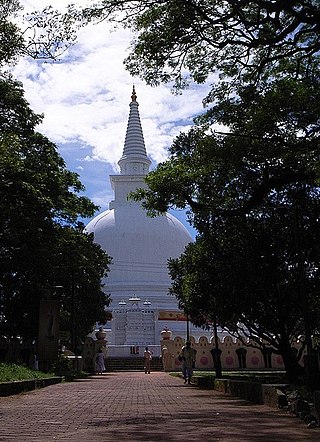
Mahiyangana Raja Maha Vihara is an ancient Buddhist temple in Mahiyangana, Sri Lanka. It is believed to be the site of Gautama Buddha's first visit to the country, and is one of the Solosmasthana, the 16 sacred religious locations in Sri Lanka. Currently this temple has been declared as one of archaeological site in Sri Lanka.
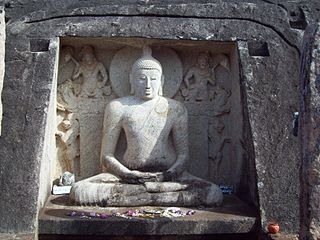
Thanthirimale is an old village in the Anuradhapura District of Sri Lanka. It is located approximately 40 km north west of the Anuradhapura city. The village is known for the ancient Buddhist temple Thanthirimale Raja Maha Vihara, situated in a nearby rock covered area.

Seruwawila Mangala Raja Maha Vihara is an ancient Buddhist temple in Trincomalee district in Eastern Province, which is among the sixteen or seventeen holiest Buddhist shrines (Solosmasthana) in Sri Lanka.

Ridi Viharaya or Silver Temple is a 2nd-century BCE Theravada Buddhist temple in the village of Ridigama, Sri Lanka. Built during the reign of Dutthagamani of Anuradhapura, the temple is considered as the place where the silver ore, which provided silver to complete Ruwanwelisaya; one of the largest stupa in Sri Lanka, was discovered. According to the chronicles Mahavamsa and Thupavamsa, the Ridi Viharaya complex was built in gratitude for helping him cherish his dream of completing Ruwanwelisaya.

Bellanwila Rajamaha Viharaya is a Buddhist temple situated in Bellanwila, Colombo District, Sri Lanka. Located around 12 km south to the Colombo city, near Dehiwala - Maharagama road, the temple attracts hundreds of devotees daily and is famous for its annual Esala Perehera festival which usually takes place in the month of August or September. One of the most venerated Buddhist temples in Sri Lanka, many devotees flock to worship the sacred Bo tree of Bellanwila Rajamaha Vihara, which is considered to be one of the first offshoots of Jaya Sri Maha Bodhi in Anuradhapura, Sri Lanka. The present chief incumbent of Bellanwila Rajamaha Vihara is Ven. Dr. Bellanwila Dhammaratana Nayaka Thera.
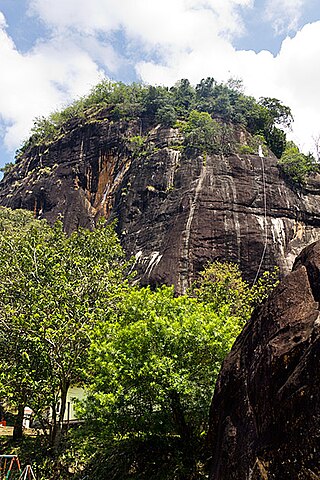
Mulkirigala Raja Maha Vihara is an ancient Buddhist temple in Mulkirigala, Sri Lanka. It has been built on a 205 m (673 ft) high natural rock, surrounded with another four rocks known as Benagala, Kondagala, Bisogala and Seelawathiegala. The temple site is located about 2 km (1.2 mi) from the Mulkirigala junction and can be reached from either Dikwella or Tangalle towns. The temple has been formally recognised by the Government as an archaeological site in Sri Lanka. The designation was declared on 8 April 1988 under the government Gazette number 501.

Magul Maha Viharaya is an ancient Buddhist temple situated in Lahugala, Ampara District of Sri Lanka. The temple lies on the northern edge of the Lahugala National Park, about 22 km off from Siyambalanduwa town and about 11 km off Pottuvil town. Lahugala has been part of the Kingdom of Ruhuna in ancient Sri Lanka. The ruins of Magul Maha Vihara are one of the major tourist attractions of the Eastern province. This temple is also an archaeologically protected monument of the country.

Pusulpitiya Raja Maha Vihara is an ancient Buddhist temple which is located in Pusulpitiya village, Nuwara Eliya District, Sri Lanka. It is situated in Kotmale about 3 miles from Morape on the banks of the Kotmale Oya. Currently this temple has been recognized as an archaeological protected site in Sri Lanka.
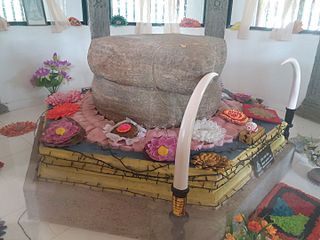
Delgamuwa Raja Maha Vihara is an ancient Buddhist temple situated in Kuruvita of Ratnapura District, Sri Lanka. This temple is reputed as the hiding place of the tooth relic of Buddha during the ruling period of Portuguese in the country.

Warana Raja Maha Vihara is an ancient Buddhist temple situated in Thihariya, Gampaha District, Sri Lanka. The temple is located approximately 5 km (3.1 mi) away from the Colombo - Kandy highway. Currently this temple has been recognized as an archaeological protected site in Gampaha District by Archaeological department.
Lahugala is a small town in Ampara District, Eastern Province of Sri Lanka. The town is located on Colombo-Batticaloa main road approximately 14 km (8.7 mi) away from Pothuvil town.

Lahugala Kota Vehera or Kota Vehara Raja Maha Vihara is an ancient Buddhist temple situated in Lahugala, Ampara District, Sri Lanka. The temple is located in Pansalgoda Grama Niladari division of Lahugala DS and lies on Colombo - Batticaloa main road about 10 km (6.2 mi) far from Pothuvil town. The temple has been formally recognised by the Government as an archaeological site in Sri Lanka. The designation was declared on 10 October 2014 under the government Gazette number 1884. The protected monuments include the ancient Dagaba, building sites with stone pillars, flight of steps carved on natural rock plain and drip ledged caves. The Stupa in the Vihara has been identified as one of four Kota Vehera Styled structures found around Sri Lanka.

Kotte Raja Maha Vihara is a historic Buddhist temple situated in Sri Jayawardenepura Kotte, Western province, Sri Lanka. It is located near to the historic building Pita Kotte Gal Ambalama at the Pita Kotte junction on Kotte road. The temple has been formally recognised by the Government as an archaeological site in Sri Lanka. The designation was declared on 17 May 2013 under the government Gazette number 1811.

Aramanapola Raja Maha Vihara or Ganegama Rankoth Vihara is an ancient Buddhist temple in Ganegama, Sri Lanka. The Vihara is located approximately 2.5 km (1.6 mi) far away from the Pelmadulla town on Colombo - Batticaloa main road (A4). The temple has been formally recognised by the Government as an archaeological site in Sri Lanka. The designation was declared on 2 March 1951 under the government Gazette number 10217.

Kanabiso Pokuna Raja Maha Vihara is an ancient Buddhist temple in Monaragala District, Sri Lanka. The temple is located in Handapanagala village approximately 12 km (7.5 mi) distance from Wellawaya town. The temple has been formally recognised by the Government as an archaeological site in Sri Lanka. The designation was declared on 22 November 2002 under the government Gazette number 1264.

The Unagalawehera Rajamaha Viharaya is a Buddhist temple in Hingurakgoda, Sri Lanka. It is 6 km (3.7 mi) south of Hingurakgoda and 7 km (4.3 mi) north of Polonnaruwa. It is an ancient site with temple complexes and ruins which are considered to belong to the early period of the Anuradhapura era.


